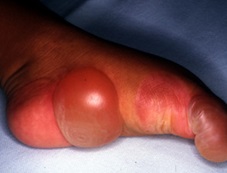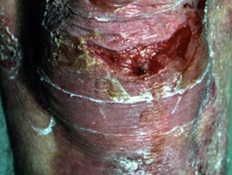How do you treat epidermolysis bullosa?
What is epidermolysis bullosa?

Epidermolysis bullosa (EB) is a group of rare genetic disorders characterised by extremely fragile skin that causes painful blisters and tears with any friction. The four main types of EB include EB simplex, junctional EB, dystrophic EB and Kindler syndrome. Diagnosis is made based on the clinical manifestations, a skin biopsy or genetic testing. EB is a debilitating disease with no cure. The treatment for epidermolysis bullosa is mainly supportive care and preventing complications such as malnutrition, infection and skin cancer. Promising treatments are still under research like gene therapy. Junctional EB has poor outcomes but other types of EB generally have a normal life expectancy.
What are the symptoms of EB?
Most EB is diagnosed at birth but the severity varies from different forms and types. Individuals with mild EB only manifest symptoms of painful blisters and skin shearing after they start crawling and walking but the severe ones can have symptoms at birth. Besides skin manifestations, some forms of EB also have problems with the digestive tract and urinary tract. For example, oesophagal strictures, anal fissures and rectal tear may develop due to scarring as a result of recurrent blistering on the mucous membrane. Other problems include nail dystrophy, corneal blisters and oral blisters.
If there is no cure, how do we treat EB?
Supportive care and regular monitoring is the main management for EB treatment, which involves proper wound care, infection control, pain management, nutritional support and complications management.
Skin and wound care
- Bath in saltwater as wounds can be painful in normal water. Prepare a tub of saltwater by dissolving 1kg of pool salt in 160L of water. Keep the water warm for little babies. If bathing is refused, gently irrigate the skin and wound with warm sterile saltwater, then cover it with non-stick dressings or foam dressings.
- When changing dressings, do it on one limb at a time to prevent self-inflicted injury from kicking the bare skin of the opposite limb. Off the fan before removing dressing to avoid pain from flowing air. If sticky dressing is applied, remove it by soaking in the bath.
- When using disposable diapers, line soft materials underneath the elastic edges to prevent injury to the skin. Protect diaper area with petroleum jelly.
- Clothing can help to prevent self-inflicted skin injury from kicking or rubbing. Turn clothing inside out to prevent skin injury from the seams.
- For foot blisters, poke it at the lowest point to allow gravitational drainage. Some prefer sterile scissors.
- Consult a podiatrist for specialised and appropriate orthotics, socks and footwear to minimise friction injury. For example, silver fibre socks and bamboo socks are soft. Shoes should have a comfortable fit with a rounded toe box and laces.
- There may be an infection if wounds are non-healing, producing pus and fever. Visit a doctor immediately to receive prompt treatment.
Pain management
- Analgesics like paracetamol and nonsteroidal anti-inflammatory drugs (NSAIDs) can be used for mild to moderate pain.
- For severe pain, opioids (codeine and morphine) or anxiolytics (diazepam, lorazepam, midazolam) are recommended.
Nutritional support is crucial for optimal growth, development, immune system and quality life. Malnutrition occurs due to limited food and nutrients due to complications such as painful oral ulcers, oesophagal strictures and painful defecations. Moreover, the constant skin lesions cause loss of fluid and nutrients.
- Breastfeeding is recommended for babies with EB. If feeding is problematic or babies having trouble gaining weight, doctors may need to temporarily feed them with a tube into the stomach.
- Supplement with adequate minerals and vitamins such as iron, zinc, calcium and vitamin D. These micronutrients are important for the development of red blood cells, bone and immune system.
Dental care
- Use a soft, small toothbrush and practice gentle brushing to avoid mucosa injury. Rinse mouth with a salt solution to gently clean the mucosal surfaces.
Parents and caretakers can learn more from websites such as debra.org on ways to care for individuals with EB. For other complications, it is advised to seek professional opinions and recommendations. We encourage joining a support group caring as caring for individuals with EB can be stressful, laborious and expensive.
